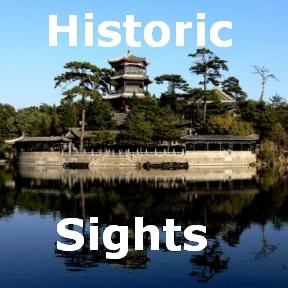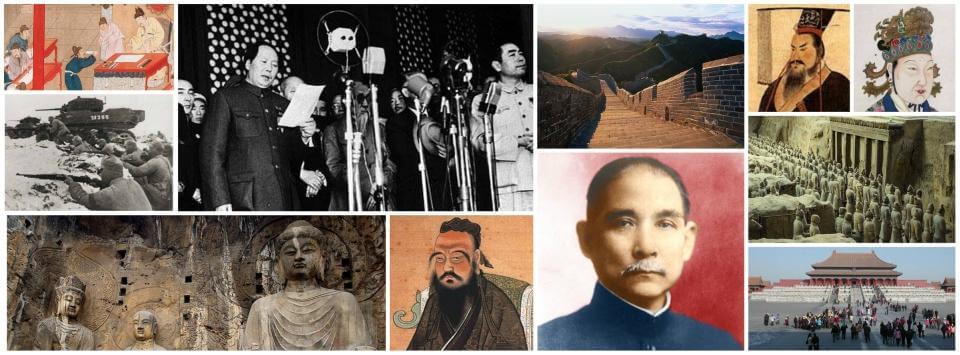
Liangzhu Ancient City
The information contained here are subject to change. Chinese History Digest is not responsible or liable if any changes should occur. If you can read Chinese, you can also check the official website of the Liangzhu Archaeological Site and the Liangzhu Museum for the latest information.
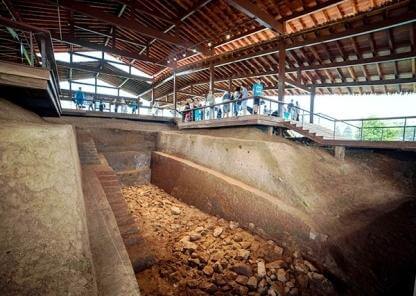 the Archaeological Ruins of Liangzhu City are protected inside the Liangzhu Ancient City Ruins ParkThe Archaeological Ruins of Liangzhu City are a UNESCO world heritage site (since 2019) that is comprised of the ancient City Site, the Yaoshan Site (an altar and cemetery) and several ancient dams and reservoirs. As the most important among these sights, the ancient City Site can be seen inside the Liangzhu Ancient City Ruins Park. This recently opened archeology park is located in the Yuhang district of Hangzhou, the capital of Zhejiang province. Thousands of the ancient relics that were excavated from the above-mentioned sites are on display at the Liangzhu Museum that lies only about 7km away inside the Liangzhu Meilizhou Park.
the Archaeological Ruins of Liangzhu City are protected inside the Liangzhu Ancient City Ruins ParkThe Archaeological Ruins of Liangzhu City are a UNESCO world heritage site (since 2019) that is comprised of the ancient City Site, the Yaoshan Site (an altar and cemetery) and several ancient dams and reservoirs. As the most important among these sights, the ancient City Site can be seen inside the Liangzhu Ancient City Ruins Park. This recently opened archeology park is located in the Yuhang district of Hangzhou, the capital of Zhejiang province. Thousands of the ancient relics that were excavated from the above-mentioned sites are on display at the Liangzhu Museum that lies only about 7km away inside the Liangzhu Meilizhou Park.
During prehistoric times, Liangzhu City was the urban center of the Liangzhu culture. This neolithic culture existed for about 1000 years from around 3300 BC until about 2300 BC. More than 600 Liangzhu culture sites have so far been identified in the area around the Taihu Lake in the Yangtze River Delta. The Liangzhu Ancient City site was the culture's urban center and this is where the ruling elite class resided that controlled the surrounding smaller communities. Due to this strictly hierarchical organization, historians regard the Liangzhu culture as the oldest state-based society in Eastern Asia. In China, the Liangzhu culture is also often cited as proof for the country's "5000 years of continuous history" claim.
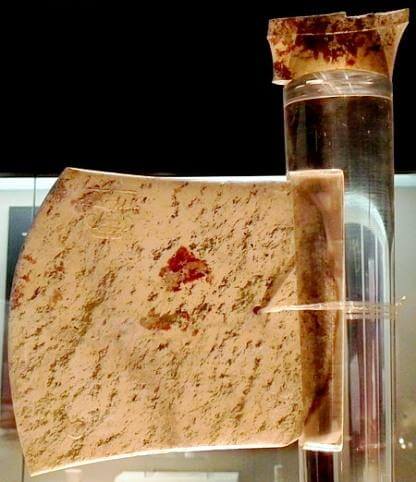 jade axe - yue - excavated at the Liangzhu SiteThe Liangzhu people prefered to build their thatched-roof houses near rivers or shorelines. Whereas semi-subterranean dwellings were constructed on higher ground, houses in low-lying areas were typically built on stilts. The excellent craftsmanship of the Liangzhu people can not only be seen in the shiny black pottery it produced. The culture was especially skilled in the production of jade objects but Liangzhu craftsmen also worked with a variety of other materials such as lacquer, ivory, silk and even corundum. This mineral is more commonly known as sapphire, except for red corundum which is known as ruby. Up to now, the Liangzhu culture is the only prehistoric culture that is known to have worked with this extremely hard mineral. Astonishingly, it has been found that diamonds were used in some way to polish the corundum burial axes that have been excavated. That discovery is proof for the earliest use of diamond tools worldwide, thousands of years earlier than the next known use of diamonds around 500 BC.
jade axe - yue - excavated at the Liangzhu SiteThe Liangzhu people prefered to build their thatched-roof houses near rivers or shorelines. Whereas semi-subterranean dwellings were constructed on higher ground, houses in low-lying areas were typically built on stilts. The excellent craftsmanship of the Liangzhu people can not only be seen in the shiny black pottery it produced. The culture was especially skilled in the production of jade objects but Liangzhu craftsmen also worked with a variety of other materials such as lacquer, ivory, silk and even corundum. This mineral is more commonly known as sapphire, except for red corundum which is known as ruby. Up to now, the Liangzhu culture is the only prehistoric culture that is known to have worked with this extremely hard mineral. Astonishingly, it has been found that diamonds were used in some way to polish the corundum burial axes that have been excavated. That discovery is proof for the earliest use of diamond tools worldwide, thousands of years earlier than the next known use of diamonds around 500 BC.
The first evidence that a neolithic culture once thrived in the area around the town of Liangzhu was uncovered during trial excavations between December 1936 and March 1937. These first excavations of the Liangzhu Site were led by Shi Xingeng, a researcher of the West Lake Museum in Hangzhou. The black pottery and ancient stone tools that were unearthed during these excavations attracted some attention but failed to reveal the full extent of the Liangzhu Site's historical significance.
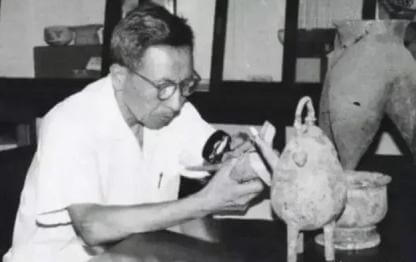 photo of Shi Xingeng who led the first trial excavations of the Liangzhu SiteThat all changed during the mid-1980s when a large number of highly sophisticated jadewares were discovered at burial sites for the elite castes of Liangzhu society. Further important discoveries were made during the last two decades. A large water conservancy system that was used for flood protection and irrigation was uncovered. The four ancient city walls of Liangzhu Ancient City that are still more than 4 meters tall in some sections were discovered as well. The most spectacular find though was the discovery of the ruins of a 30-hectare palace complex which was built on a huge earthen platform.
photo of Shi Xingeng who led the first trial excavations of the Liangzhu SiteThat all changed during the mid-1980s when a large number of highly sophisticated jadewares were discovered at burial sites for the elite castes of Liangzhu society. Further important discoveries were made during the last two decades. A large water conservancy system that was used for flood protection and irrigation was uncovered. The four ancient city walls of Liangzhu Ancient City that are still more than 4 meters tall in some sections were discovered as well. The most spectacular find though was the discovery of the ruins of a 30-hectare palace complex which was built on a huge earthen platform.
The population of Liangzhu Ancient City is estimated to have peaked somewhere between 22,900 and 34,500 people according to Liu Bin, the former director of the Zhejiang Provincial Institute of Cultural Relics and Archaeology. Ordinary residents lived on the outskirts of the city whereas the elites lived in the palace area at its center. There was one single road that led through the city gates but most residents traversed the city by boat along an intricate network of waterways that consisted of both canals and the natural path of rivers. Despite Liangzhu City's monumental water management system that was unprecedented in the world at that time, repeated flooding by seawater eventually led to the downfall of Liangzhu society. When the increased salinity of the soil made rice cultivation more and more difficult, the city's residents gradually began to move away to other more fertile areas.
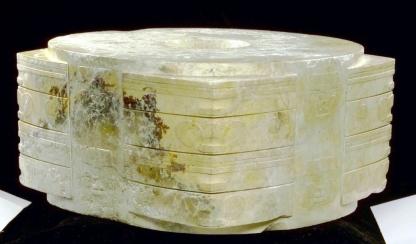 jade cong excavated from Liangzhu Ancient City's Fanshan CemeteryAnyone that wants to learn more about the Liangzhu culture and see some of the exceptional jadeware this culture produced should visit the Liangzhu Museum. It is in fact highly advisable to visit this museum before going to see the Archaeological Ruins of Liangzhu City (which can be seen inside the Yaoshan Ruins Park and the Liangzhu Ancient City Ruins Park). This order of visit will help history buffs to understand the function and significance of the various archaeological ruins much better. The Liangzhu Museum lies just a short 1.4km walk to the north of the Liangzhu Cultural Village where our recommended hotel, the Narada Resort & Spa Liangzhu is located. You can read a thorough review of the services and amenities of this luxurious 5-star hotel near the bottom of this page.
jade cong excavated from Liangzhu Ancient City's Fanshan CemeteryAnyone that wants to learn more about the Liangzhu culture and see some of the exceptional jadeware this culture produced should visit the Liangzhu Museum. It is in fact highly advisable to visit this museum before going to see the Archaeological Ruins of Liangzhu City (which can be seen inside the Yaoshan Ruins Park and the Liangzhu Ancient City Ruins Park). This order of visit will help history buffs to understand the function and significance of the various archaeological ruins much better. The Liangzhu Museum lies just a short 1.4km walk to the north of the Liangzhu Cultural Village where our recommended hotel, the Narada Resort & Spa Liangzhu is located. You can read a thorough review of the services and amenities of this luxurious 5-star hotel near the bottom of this page.
Other attractions that can be found inside the Liangzhu Cultural Village are a food street with dozens of restaurants and coffee & tea houses, a children's park, Meilizhou Church and the Liangzhu Culture and Art Center. This modern art center was designed by the famous Japanese architect Tadao Ando. It sometimes hosts art exhibitions, markets or other events, so don't forget to check the listings when you are there! Travellers that are interested in Buddhism might also consider visiting the Daxiong Temple which lies just 1.6km away from the Liangzhu Culture and Art Center.
How to travel to Hangzhou?
| Airport: | Hangzhou Xiaoshan International Airport (HGH) |
| Train Station: | Hangzhou Railway Station, Hangzhou East Railway Station, Hangzhou South Railway Station |
| Bus: | the bus lines 428M, 257H and 1222M go from central Hangzhou to the area where the Liangzhu-related sights are located |
Liangzhu Museum
Opening Hours
9am - 5pm
(no entry after 4.30pm)
closed on Mondays
Entrance Ticket Prices
Free Admission
Visitors must make advance online reservation at least 1 day in advance
The Liangzhu Museum first opened its doors to the public in October 2008. Between August 2017 and June 2018 it was renovated and upgraded. The museum showcases a collection of Liangzhu culture relics that were unearthed during the various archaeological excavations of the Liangzhu Site. Travellers are advised to visit the Liangzhu Museum first before going to see the Archaeological Ruins of Liangzhu City inside the Liangzhu Ancient City Ruins Park. The museum and the archaeological ruins park are about 7km away from each other.
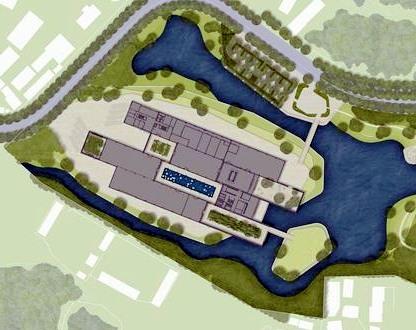 setting of the Liangzhu Museum within the Liangzhu Meilizhou ParkThe Liangzhu Meilizhou Park that the Liangzhu Museum is located in used to be a contaminated industrial site. Levin Monsigny Landschaftsarchitekten transformed this site into a beautifully landscaped park with hills and manmade streams. The modern museum building with its five internal courtyards was designed by the renowned architecture firm David Chipperfield Architects. Guests that decide to stay overnight at the Narada Resort & Spa Liangzhu (which is reviewed further down on this page) only need to walk about 2km north on this route to get to the museum. The museum's entrance can be reached via a bridge that crosses a manmade lake. This lake surrounds the museum building on three sides. Another bridge at the back of the museum leads to a small island that is sometimes used for outdoor exhibitions.
setting of the Liangzhu Museum within the Liangzhu Meilizhou ParkThe Liangzhu Meilizhou Park that the Liangzhu Museum is located in used to be a contaminated industrial site. Levin Monsigny Landschaftsarchitekten transformed this site into a beautifully landscaped park with hills and manmade streams. The modern museum building with its five internal courtyards was designed by the renowned architecture firm David Chipperfield Architects. Guests that decide to stay overnight at the Narada Resort & Spa Liangzhu (which is reviewed further down on this page) only need to walk about 2km north on this route to get to the museum. The museum's entrance can be reached via a bridge that crosses a manmade lake. This lake surrounds the museum building on three sides. Another bridge at the back of the museum leads to a small island that is sometimes used for outdoor exhibitions.
Three of the four exhibition halls inside the Liangzhu Museum host a permanent exhibition about the Liangzhu culture. The 4th hall is used for temporary exhibitions. The museum combines traditional museum features such as display cabinets, historical scene recreations and large-scale oil paintings with the latest in digital display technology. There is even a Virtual Reality exhibition (where visitors have to wear VR goggles) which however costs a small extra fee! More than 600 of the more than 3,000 cultural relics that are in the Liangzhu Museum's collection are on permanent display. Themed temporary exhibitions are used to show some of the other items to the public. In fact, a large part of the museum's Liangzhu civilization relics were just excavated during the last decade! Unsurprisingly, the Liangzhu culture's famed jadeware and pottery make up the lion's share among the exhibits. However, other types of objects such as lacquerware and stone and bone objects are shown to the public as well.
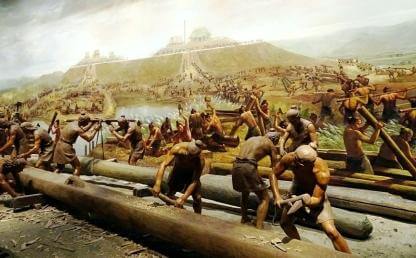 the Liangzhu culture built the world's oldest hydraulic engineering systemThe theme of the first of the three exhibition halls is "The Early Wetland State". It focuses on the Liangzhu culture's system of agriculture that was based on the cultivation of rice and the domestication of pigs. The ideal living and farming conditions near the Taihu Lake helped the Liangzhu civilization to prosper. This strong economic basis made the formation of handicraft industries possible. These industries such as jade carving, pottery making, stone processing, lacquer coating and the production of textiles gradually became more and more specialized and sophisticated.
the Liangzhu culture built the world's oldest hydraulic engineering systemThe theme of the first of the three exhibition halls is "The Early Wetland State". It focuses on the Liangzhu culture's system of agriculture that was based on the cultivation of rice and the domestication of pigs. The ideal living and farming conditions near the Taihu Lake helped the Liangzhu civilization to prosper. This strong economic basis made the formation of handicraft industries possible. These industries such as jade carving, pottery making, stone processing, lacquer coating and the production of textiles gradually became more and more specialized and sophisticated.
The second exhibition hall's theme "A Sacred Land of Civilization" relates to the planning, construction and structural layout of the ancient city of Liangzhu. After visiting this hall of the Liangzhu Museum, travellers will have a much easier time to make sense of the various Archaeological Ruins of Liangzhu City that can be found throughout the area. In addition to information about the Palace Area, Inner City with its tombs and workshops and Outer City where most people lived, the displays in this hall also focus on the ruins of villages, altars and cemeteries that have been excavated in the outlying areas. The water conservancy system of Liangzhu Ancient City with its advanced system of dams and canals is thoroughly explained as well.
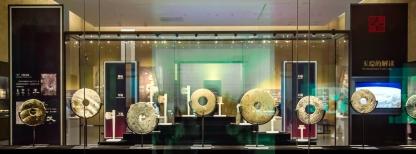 jade discs - bi - on display at the Liangzhu MuseumFor most visitors, the third permanent exhibition hall of the Liangzhu Museum is the highlight of their visit. This is the place where the Liangzhu culture's amazing jadeware can be seen such as jade vessels (jade cong), jade discs (jade bi) and jade axes (jade yue). The Liangzhu civilization used jade as a symbol that unified spiritual and political power. This merger between religion and the state is reflected in the theme of the third hall "Jade as the Spiritual Symbol of the State". Ceremonial jades were used in ritual settings but were also a symbol of power. During the time of the Liangzhu society, a person's status and function within the hierarchy of the state could be seen by the ceremonial jades he possessed.
jade discs - bi - on display at the Liangzhu MuseumFor most visitors, the third permanent exhibition hall of the Liangzhu Museum is the highlight of their visit. This is the place where the Liangzhu culture's amazing jadeware can be seen such as jade vessels (jade cong), jade discs (jade bi) and jade axes (jade yue). The Liangzhu civilization used jade as a symbol that unified spiritual and political power. This merger between religion and the state is reflected in the theme of the third hall "Jade as the Spiritual Symbol of the State". Ceremonial jades were used in ritual settings but were also a symbol of power. During the time of the Liangzhu society, a person's status and function within the hierarchy of the state could be seen by the ceremonial jades he possessed.
After having carefully scrutinized all the exhibits in the three permanent exhibition halls of the Liangzhu Museum, visitors that are not afraid of putting on a VR headset might want to give the museum's unique Virtual Reality exhibition a try! After their museum excursion and perhaps a good night of rest at the Narada Resort & Spa Liangzhu nearby, visitors will be well-prepared to see the various Archaeological Ruins of Liangzhu City in real life later in the afternoon or on the next day.
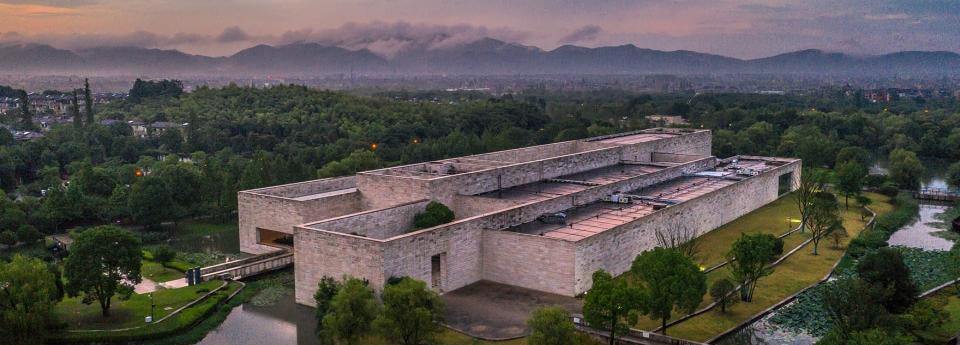 view of the Liangzhu Museum near Hangzhou
view of the Liangzhu Museum near Hangzhou
How to get to the Liangzhu Museum?
| Address: | Liangzhu Museum, No.1 Meilizhou Road, Yuhang District, Hangzhou, Zhejiang province, China |
| Tel.Nr.: | +86 571 887 73875 |
| Metro: | Liangzhu Station - Subway Line 2 |
Archaeological Ruins of Liangzhu City
Opening Hours
Liangzhu Ancient City Ruins Park: 9am - 5pm
(no entry after 4pm)
Yaoshan Ruins Park: 9am - 5pm
(no entry after 4pm)
Tickets are reserved online
Entrance Ticket Prices
Liangzhu Ancient City Ruins Park: 80 yuan
50 yuan for students, children and elderly (60 - 70)
20 yuan for 70+ elderly, disabled people
Free Admission for children under 6, children below 1.2m
Yaoshan Ruins Park: Free Admission
The Archaeological Ruins of Liangzhu City have been inscribed on the UNESCO world heritage list in 2019. They are comprised of four different sites that are located to the northwest of Hangzhou. On this page of the UNESCO world heritage website, you can see a map that shows the location of the four sites. The four sites are:
- City Site (located inside the Liangzhu Ancient City Ruins Park)
- Yaoshan Site (located inside the Yaoshan Ruins Park)
- High-dam at the Mouth of the Valley Site
- Low-dam on the Plain & Causeway in front of the Mountains Site
1. City Site - Liangzhu Ancient City Ruins Park
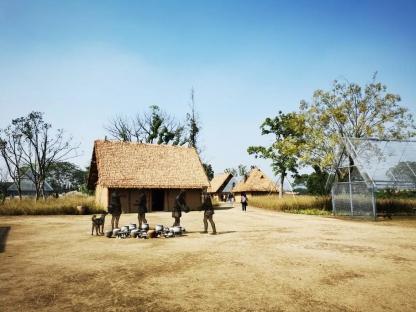 metal grid figures and reconstructed houses inside of the Liangzhu Ancient City Ruins ParkThe City Site is the area where the city of Liangzhu once stood. This ancient city that was mainly built between 3000 BC and 2850 BC was the capital and the center of power of Liangzhu society. Its inner city which measured about 1,700 meters from east to west and 1,900 meters from north to south was surrounded by a city wall on all sides. Ruins of this former city wall remain in some areas. The entire inner city of Liangzhu (including the areas where the city wall once stood) is now fully contained within the 3.66 square-kilometer Liangzhu Ancient City Ruins Park (Chinese: 良渚古城遗址公园 Liáng zhǔ gǔchéng yízhǐ gōngyuán). You can see a large map of this park on this page. Besides showcasing and preserving the archaeological ruins of Liangzhu City, it is also an ecological park with a wetland ecosystem.
metal grid figures and reconstructed houses inside of the Liangzhu Ancient City Ruins ParkThe City Site is the area where the city of Liangzhu once stood. This ancient city that was mainly built between 3000 BC and 2850 BC was the capital and the center of power of Liangzhu society. Its inner city which measured about 1,700 meters from east to west and 1,900 meters from north to south was surrounded by a city wall on all sides. Ruins of this former city wall remain in some areas. The entire inner city of Liangzhu (including the areas where the city wall once stood) is now fully contained within the 3.66 square-kilometer Liangzhu Ancient City Ruins Park (Chinese: 良渚古城遗址公园 Liáng zhǔ gǔchéng yízhǐ gōngyuán). You can see a large map of this park on this page. Besides showcasing and preserving the archaeological ruins of Liangzhu City, it is also an ecological park with a wetland ecosystem.
There are 10 different areas inside the Liangzhu Ancient City Ruins Park which are listed further below. Visiting all of these areas takes about 3 hours. The free shuttle buses that take visitors around the park stop at all of these areas. It is also possible to rent bicycles and cycle around the park. There are service areas throughout the park where visitors can find food and drink or simply have a rest amidst pleasant surroundings.
After entering the park through the South Gate, the visitor center is the first place that you will come across. Besides housing catering facilities, a tourist guide center and a souvenir store, the visitor center includes an experience hall where visitors can travel back in time and experience life in the ancient city of Liangzhu by putting on a virtual reality headset. There is also a 5G "magic mirror" that will make male tourists appear like an ancient king of Liangzhu City, complete with a feather headdress, jade ornaments and a scepter. Female tourists will appear in the mirror like an ancient Queen.
The 10 areas inside the Liangzhu Ancient City Ruins Park are:
- City Gates & Walls
- Zhongjiagang Site Of River Courses And Workshops
- Zhishan Viewing Platform
- Fanshan Cemetery
- Ruins of the West City Wall
- Mojiaoshan Palace
- The Inner City Archaeological Experience Area
- Daguanshan Recreation Area
- Deer Garden
- Fengshan Research and Study Base
City Gates & Walls
The ruins of the ancient City Gates & Walls are located in the southern part of the Liangzhu Ancient City Ruins Park. The south wall of the ancient city of Liangzhu once extended for about 1,400 meters at this location. It was about 40 meters wide and contained two of the city's eight water gates as well as its only land gate. On the foundations of this wall, visitors will now find viewing platforms that provide a good vantage point to overlook a large part of the surrounding area. Furthermore, sculptures and metal grid figures have been set up at the site that simulate the construction of the walls and the return of a group of hunters to the city.
Zhongjiagang Site Of River Courses And Workshops
The Zhongjiagang Site Of River Courses And Workshops is located to the northeast of the above-mentioned ruins of the ancient south city wall. At this area near the Liangzhugang River and the former east city wall, visitors will find an exhibition area of recreated residences and workshops. The artisans of Liangzhu were highly skilled in the production of jadeware, lacquerware and other handicrafts. Metal grid figures and interactive exhibits are used to simulate the specialized production process of such handicrafts in the workshop area of the park.
Zhishan Viewing Platform
The Zhishan Viewing Platform has been built on top of the natural Zhishan Hill. Of all the scenic spots inside the Liangzhu Ancient City Ruins Park, it is the place that provides the best views of the Mojiaoshan Palace area that is located at the center of the ancient city of Liangzhu. The Zhishan Hill is located to the north of the Zhongjiagang Site at the northeast corner of the park. At an elevation of more than 30 meters above sea level, it connected the eastern with the northern section of the ancient city wall. There is in fact one other natural hill that the ancient city planners of Liangzhu similarly integrated into their system of fortifications. That other hill is known as the Fengshan Hill and it is located straight opposite the Zhishan Hill at the southwest corner of the ancient city wall.
The waterside terrace that can be found to the east of the Zhishan Viewing Platform is an idyllic spot to take a picture of Zhishan Hill from a distance. Here, you can also observe the water birds such as egrets and ducks up close that have made this ecological sanctuary their home.
Fanshan Cemetery
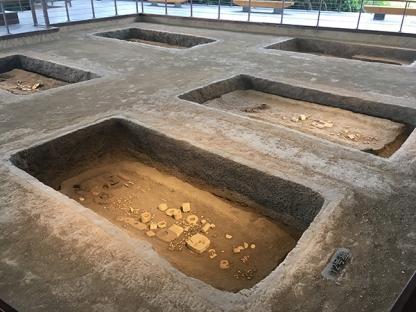 restored burial pits at the Fanshan Cemetery Exhibition areaThe Fanshan Cemetery is located between the ruins of the West City Wall and the Mojiaoshan Palace. It is only separated from the latter by a river. The archaeological excavations of the site in 1986 uncovered 11 large tombs (9 of the 11 tombs were in good condition) where the highest-status members of Liangzhu society were buried. A total of 1,226 funerary objects of the highest quality were found inside these tombs such as jadeware, lacquerware, ivory objects, pottery and stone axes (yue). Jade objects of more than 20 different types made up about 90 percent of all burial artifacts that were discovered. The largest of these jade artifacts are the jade cong and jade axe (yue) that were discovered in tomb number 12. Since these peculiar types of jade objects respectively represented divine power and military power in Liangzhu society, historians believe that tomb number 12 was the final resting place of a king of the Liangzhu people.
restored burial pits at the Fanshan Cemetery Exhibition areaThe Fanshan Cemetery is located between the ruins of the West City Wall and the Mojiaoshan Palace. It is only separated from the latter by a river. The archaeological excavations of the site in 1986 uncovered 11 large tombs (9 of the 11 tombs were in good condition) where the highest-status members of Liangzhu society were buried. A total of 1,226 funerary objects of the highest quality were found inside these tombs such as jadeware, lacquerware, ivory objects, pottery and stone axes (yue). Jade objects of more than 20 different types made up about 90 percent of all burial artifacts that were discovered. The largest of these jade artifacts are the jade cong and jade axe (yue) that were discovered in tomb number 12. Since these peculiar types of jade objects respectively represented divine power and military power in Liangzhu society, historians believe that tomb number 12 was the final resting place of a king of the Liangzhu people.
The 11 elite tombs of the Fanshan Cemetery have been restored to the condition they were in before their archaeological excavation in 1986. At the Fanshan Exhibition Hall nearby, visitors will be able to gain a better understanding of the excavation process and the historical significance of the site. Various cultural relics that were unearthed at the site are on display to the public there. Information about all the unearthed objects has been made accessible to the public through the use of a large digital display wall. Visitors simply have to click on the object they are interested in to find out everything there is to know about it.
Just like most other areas inside the Liangzhu Ancient City Ruins Park, the Fanshan Cemetery Exhibition area also contains shops where visitors can buy cultural products as well as places to buy coffee, tea or other refreshments.
Ruins of the West City Wall
The ruins of the West City Wall are located right next to the Fanshan Cemetery Exhibition area. The well-preserved parts of the ancient city wall are about 4 meters tall. In the ruined sections, the remaining parts of the wall still rise to about half of that height. The rammed-earth wall was at least 20 meters wide at the top and its foundation was built with paving stones. Added protection for the city's residents was provided by a system of internal and external moats.
At the exhibition area in this section, visitors will be able to see the excavated cornerstones at the bottom of the West City Wall. Just like at the above-mentioned south wall section, there are also themed sculptures in the areas that surround the ruins of the West City Wall. These sculptures serve to illustrate the daily life of the former residents of the ancient city of Liangzhu. Astonishingly, the population of the city may have exceeded 30,000 people at its peak according to some estimates.
Mojiaoshan Palace
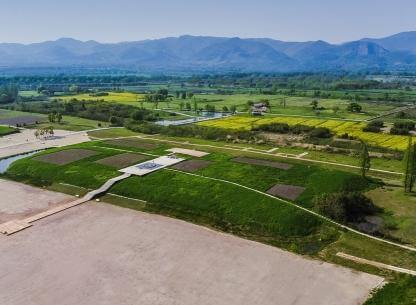 aerial view of the Mojiaoshan Palace terraceThe Mojiaoshan Palace was where the elite class of Liangzhu society lived. This area was located at the center of the ancient city of Liangzhu. On top of a 300,000-square-meter earthen terrace that rose more than 9 meters above the surrounding plain, three separate earth platforms had been artificially piled up. The royal palace stood on the biggest of the three platforms. Seven of the 35 building foundations that have been identified on it have already been excavated. The buildings of the palace were made of wood and bamboo and their surface area ranged from 300 to 900 square meters. Between the three artificial platforms was a sand square that covered an area of about 70,000 square meters. When our Liangzhu ancestors still inhabited this land, this large square was used for sacrificial ceremonies and celebrations.
aerial view of the Mojiaoshan Palace terraceThe Mojiaoshan Palace was where the elite class of Liangzhu society lived. This area was located at the center of the ancient city of Liangzhu. On top of a 300,000-square-meter earthen terrace that rose more than 9 meters above the surrounding plain, three separate earth platforms had been artificially piled up. The royal palace stood on the biggest of the three platforms. Seven of the 35 building foundations that have been identified on it have already been excavated. The buildings of the palace were made of wood and bamboo and their surface area ranged from 300 to 900 square meters. Between the three artificial platforms was a sand square that covered an area of about 70,000 square meters. When our Liangzhu ancestors still inhabited this land, this large square was used for sacrificial ceremonies and celebrations.
A thorough visit of the Mojiaoshan Palace area will take about 1 hour. Besides the central exhibition area where visitors will see a miniature model of the inner city and learn about the construction of the artificial terraces, there is also an exhibition area on the eastern slope of the main terrace. This is where about 13,000 kg of carbonized rice have been found. It is speculated that the rice was dumped there after the granary of the palace caught fire.
The Mojiaoshan Palace area was surrounded by a network of rivers and canals that crisscrossed the ancient city and served as the city's transportation pathways. The city walls had moats on each side and eight water gates made access to the city by boat much easier than on the single road that traversed it.
Daguanshan Recreation Area
The Daguanshan Recreation Area is located to the south of the Mojiaoshan Palace area. The most popular attraction in this area is a Digital Experience Hall. It uses the latest in digital display technology to transport visitors 5,000 years back in time. After watching its digital exhibits, visitors will also be able to understand how the current park and wetland landscape was formed. Furthermore, there are various catering and recreation services available to the visitors of the park in this area.
Deer Garden
The Deer Garden is located right next to the Daguanshan Recreation Area. Here, visitors will be able to watch and interact with sika deer. The introduction of more than a dozen sika deer to this area of the Liangzhu Ancient City Ruins Park is more than just a gimmick to attract tourists though. After all, deer antler fossils were unearthed during the excavation process of the Liangzhu Site. The warm and humid climate that was typical at the site 5,000 years ago was ideal for the survival of deer. The hunting of these animals was a normal part of life back then as it supplemented the protein needs of the ancient inhabitants of Liangzhu City.
The Inner City Archaeological Experience Area
The Inner City Archaeological Experience Area is located just a short distance to the west of the Daguanshan Recreation Area. This area of the park has been primarily designed as an attraction for children. Here, they can experience what it's like to participate in an archaeological excavation. However, the ceramic handicraft production experience as well as the Liangzhu jade workshop that can be found in this area will interest adults as well. Coffee and snacks are available for purchase in this area of the park.
Fengshan Research and Study Base
The Fengshan Research and Study Base is located near Fengshan Hill in the southwestern part of the Liangzhu Ancient City Ruins Park. This area is currently still under construction and therefore not yet open to the public. In the future, visitors will be able to see documentary films about the Liangzhu culture and the Liangzhu Ancient City here. There will also be a service point that provides snacks, coffee, tea and other refreshments.
2. Yaoshan Site - Yaoshan Ruins Park
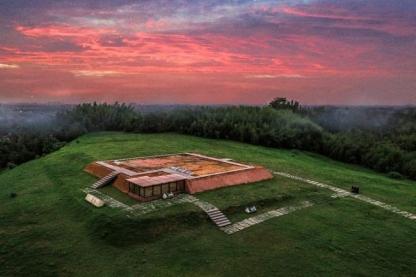 view of the Yaoshan Altar at the Yaoshan Ruins ParkThe Yaoshan Site is located inside the Yaoshan Ruins Park about 5km to the north of the City Site. There, it can be found about 35 meters above sea level on top of a hill with an irregularly shaped plane. The site covers a total area of about 66.56 hectares (0,6656 square kilometers) and consists of the sacrificial Yaoshan Altar and the Yaoshan Cemetery. Since the autumn of 2021, the Yaoshan Site has been made accessible to the public as an integral part of the Yaoshan Ruins Park.
view of the Yaoshan Altar at the Yaoshan Ruins ParkThe Yaoshan Site is located inside the Yaoshan Ruins Park about 5km to the north of the City Site. There, it can be found about 35 meters above sea level on top of a hill with an irregularly shaped plane. The site covers a total area of about 66.56 hectares (0,6656 square kilometers) and consists of the sacrificial Yaoshan Altar and the Yaoshan Cemetery. Since the autumn of 2021, the Yaoshan Site has been made accessible to the public as an integral part of the Yaoshan Ruins Park.
Construction of the site is estimated to have occurred between 3300 BC and 3100 BC. Archaeological excavations have revealed that the Yaoshan Altar was built before the Yaoshan Cemetery. It is square in shape and has a flat top. Visitors can climb to the top of it and observe its three-colored soil platform (with red being the dominant color) up close through transparent glass. Historians believe that the Liangzhu people used the altar for a variety of functions such as to make sacrificial offerings to heaven, earth and their pagan deities as well as to worship their ancestors and to observe astronomical phenomena.
The Yaoshan Cemetery covers an area of about 300 square meters to the south of the altar. It consists of 13 large rectangular earthen pit tombs that are arranged in two rows. Due to the astonishing number of high-value burial objects (678 of the 754 buried relics were jadeware!) that have been unearthed from these tombs, it is certain that its occupants belonged to the elite class of Liangzhu society.
The Yaoshan Ruins Park also contains viewing platforms on its two hills - Phoenix Hill and Mantou Hill - as well as tourism facilities such as a tourist center and a service center.
3. High-dam at the Mouth of the Valley Site
The High-dam at the Mouth of the Valley Site is located about 11km northwest of the City Site. Its construction is believed to have occurred around 3100 BC - 2850 BC. The site consists of six different dams, three in the west group and another three in the east group. The three high-dams in the west group are the Mifenglong, Shiwu and Qiuwu dam. They are located at an elevation of about 40 meters above sea level and their length varies from about 100 to 180 meters. The three other high-dams that are clustered together in the east group are the Ganggongling, Laohuling and Zhoujiafan dam. These dams are located at a slightly lower elevation of about 30 meters above sea level and their length varies from about 100 to 200 meters.
Each group of dams blocked a mouth of the valley. The dams adjusted the water level in the system of rivers and canals that crisscrossed the valley below by creating reservoirs. In this way, flooding of the rice fields and the city site was largely prevented and a sufficient water level for transportation and daily water use was ensured.
4. Low-dam on the Plain & Causeway in front of the Mountains Site
The Low-dam on the Plain & Causeway in front of the Mountains Site is located to the north and west of the City Site. This largest project in the water conservancy system of the ancient city of Liangzhu is believed to have been built from around 3000 BC to 2600 BC. The Causeway in front of the Mountains is about 5km long and runs from east to west. It is also known as the Tangshan Levee and it was built to prevent the water in the reservoir from spilling over in this area to the north and northwest of the City Site.
The west end of the Causeway is connected to the low dams on the plain. These are four individual dams with a height of about 10 meters. The four low dams are the Shizishan dam, Liyushan dam, Guanshan dam and Wutongnong dam. By connecting isolated mounds on the plain, these four dams created the southern boundary of the triangular water reservoir that covered an area of around 8.5 square kilometers. The about 5,100-year-old system of dams, levees, ditches etc. that make up the Liangzhu water management system are the world's oldest hydraulic engineering system. Altogether, the water management system of Liangzhu Ancient City controlled the water flow over more than 10,000 hectares of land and was capable of holding back about 6.5 billion cubic meters of water.
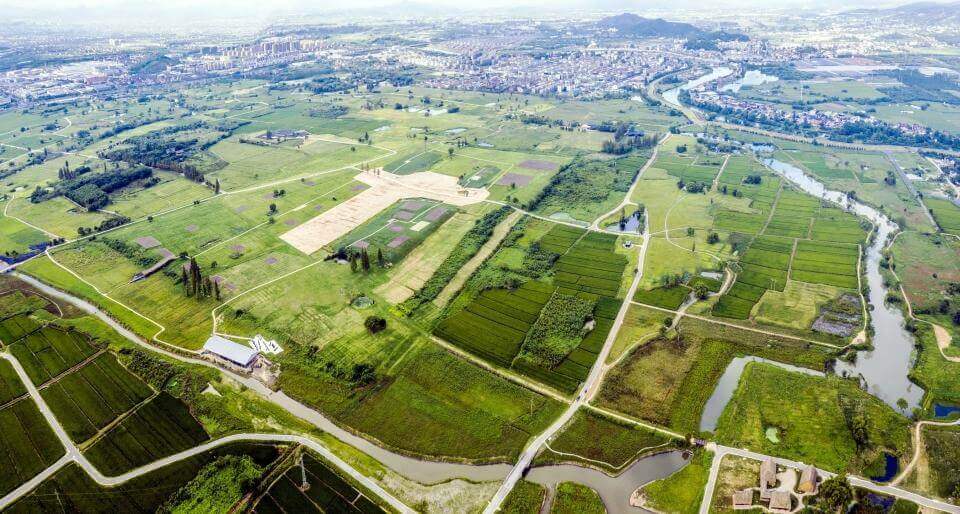 aerial view of the Liangzhu Ancient City Ruins Park near Hangzhou
aerial view of the Liangzhu Ancient City Ruins Park near Hangzhou
How to get to the Liangzhu Ancient City Ruins Park near Hangzhou?
| Address: | Liangzhu Ancient City Ruins Park, Pingyao Town, Yuhang District, Hangzhou, Zhejiang province, China |
| Tel.Nr.: | +86 571 8585 5300 |
| Metro: | Liangzhu Station - Subway Line 2 - then take bus 1222M from there to the Archaeological Ruins site (良渚古城遗址). |
| Bus: | Liangzhu Ruins Park South (bus lines from Hangzhou: 313, 348, 348 Express, 430, 764, 787, 8B) |
On the following Google map, the blue icons show the location of the Liangzhu Museum as well as the Yaoshan Ruins Park and the Liangzhu Ancient City Ruins Park. The yellow hotel bed icon shows the location of the Narada Resort & Spa Liangzhu which is our recommended hotel nearby. Zoom out of the map to see the location of the Shangri-La Hotel Hangzhou and the Amanfayun which are our recommended hotels in Hangzhou. Both of them are located near Hangzhou's famous West Lake. Further below on this page, you can read a review of the services and amenities of all of these hotels. In case you are planning a trip to China, you could support this website by using the provided affiliate links to check prices and book your hotel accomodation!
You can book hotels in China with both of our affiliate partners Agoda and Trip.com. No matter whether you choose Agoda or Trip.com, you will find many offers on each of these platforms that will allow you to make a risk-free booking with the possibility of free cancellation until a clearly stated date and time, sometimes as late as on the intended date of arrival. However, some deals require prepayment and don't permit cancellation without fees. In that case, the incurred cancellation fees are clearly stated.
When following an Agoda link, the search results will show you prices, availability and special offers for your chosen dates with the recommended hotel in the top search position as well as for other hotels in the same area. Links to Trip.com will take you to the specific hotel webpage where you can then search for availability, prices and special deals with your chosen dates.
The provided information was thoroughly researched from various hotel booking websites. Chinese History Digest is not responsible if any information regarding the provided services and amenities might have changed.
Recommended Hotel near the Liangzhu Museum
The Narada Resort & Spa Liangzhu that is reviewed below is the closest 5-star hotel to the Liangzhu Museum. It is located inside the Liangzhu Cultural Village, just about a 20-minute walk away from the museum. In addition to the links to Agoda that are used in the review below, this hotel is also available for booking on Trip.com by following this link.
Narada Resort & Spa Liangzhu
 The Narada Resort & Spa Liangzhu opened its doors in 2008 and was renovated in 2015. This 5-star hotel is located near a lake in a park-like setting inside the Liangzhu Cultural Village. Travellers that plan to visit the Liangzhu Museum and all the other sights of the Liangzhu Cultural Village would do well to make this luxurious hotel their base of exploration. The museum lies just a 20-minute walk away and access to the neighborhoods around the hotel is facilitated through a convenient shuttle service. The best way to reach Hangzhou's city center is by metro from the Liangzhu Metro Station which is quite close to the hotel as well. The Narada Resort & Spa Liangzhu provides a taxi booking service and also rents bicycles. Travellers that prefer to explore Hangzhou's surroundings on four wheels can also rent a car at the hotel (free parking is available). Transfer to/from the airport (about a 50-minute drive) costs an extra fee of 1,100 yuan and needs to be requested at least 3 days in advance. Transfer to/from the railway station or bus station can also be booked for an extra fee of 750 yuan until 1 day in advance.
The Narada Resort & Spa Liangzhu opened its doors in 2008 and was renovated in 2015. This 5-star hotel is located near a lake in a park-like setting inside the Liangzhu Cultural Village. Travellers that plan to visit the Liangzhu Museum and all the other sights of the Liangzhu Cultural Village would do well to make this luxurious hotel their base of exploration. The museum lies just a 20-minute walk away and access to the neighborhoods around the hotel is facilitated through a convenient shuttle service. The best way to reach Hangzhou's city center is by metro from the Liangzhu Metro Station which is quite close to the hotel as well. The Narada Resort & Spa Liangzhu provides a taxi booking service and also rents bicycles. Travellers that prefer to explore Hangzhou's surroundings on four wheels can also rent a car at the hotel (free parking is available). Transfer to/from the airport (about a 50-minute drive) costs an extra fee of 1,100 yuan and needs to be requested at least 3 days in advance. Transfer to/from the railway station or bus station can also be booked for an extra fee of 750 yuan until 1 day in advance.
The Narada Resort & Spa Liangzhu has a total of 312 rooms including family rooms and some suites. Both lake view and mountain view rooms are available and some rooms even have a balcony or terrace. Smoking is only allowed at the hotel's designated smoking areas. The rooms are air-conditioned and equipped with a safe, refrigerator, minibar, coffee or tea maker and flatscreen TV with cable channels. Free bottled water as well as instant coffee & tea are provided in the rooms. Free internet access is not only available through Wi-Fi but also LAN cable. The hotel provides free luggage storage and laundry service (including dry cleaning) is available. Buffet breakfast is included in most room rates but can also be purchased separately for 88 yuan per person. In addition to 3 restaurants, a lobby bar and a coffee shop, there is also a convenience store inside the Narada Resort & Spa Liangzhu which enables guests to save time and money through self-catering. Besides having free access to the hotel's fitness center and swimming pool (indoor and outdoor), guests can also exercise by playing tennis, squash, table tennis, bowling or billiards at this hotel. For relaxation, hotel guests can book a massage and use the hotel's sauna, steamroom, hot spring, spa and karaoke facilities.
0.9 miles away
Check availability & prices!Recommended Hotels in Hangzhou
The Shangri-La Hotel Hangzhou that is reviewed below is the closest 5-star hotel to the Yue Fei Temple in Hangzhou. In addition to the links to Agoda that are used in the review below, this hotel is also available for booking on Trip.com by following this link.
Shangri-La Hotel Hangzhou
 The Shangri-La Hotel Hangzhou is a luxurious 5-star hotel that is nestled amidst rolling hills and lush greenery within close walking distance of both Hangzhou's city center and West Lake. The views from this location are stunning in all directions and dominated by Solitary Hill Island and the graceful Xiling Bridge on one side and the landscape of Baoshi Mountain on the other side. The Yue Fei Temple is located right next to the Shangri-La Hotel Hangzhou and many other attractions like the Leifeng Pagoda (2.7 km) or the city's exciting night markets can be reached on foot from here.
The Shangri-La Hotel Hangzhou is a luxurious 5-star hotel that is nestled amidst rolling hills and lush greenery within close walking distance of both Hangzhou's city center and West Lake. The views from this location are stunning in all directions and dominated by Solitary Hill Island and the graceful Xiling Bridge on one side and the landscape of Baoshi Mountain on the other side. The Yue Fei Temple is located right next to the Shangri-La Hotel Hangzhou and many other attractions like the Leifeng Pagoda (2.7 km) or the city's exciting night markets can be reached on foot from here.
However, it is not even necessary to walk everywhere since there is also a convenient shuttle service that provides easy access to the surrounding neighborhoods. Guests also have the option to rent bicycles at the Shangri-La Hotel Hangzhou (and then cycle around the West Lake perhaps?) or book a rental car (free parking is available). Reaching the Hangzhou Xiaoshan International Airport typically takes about 45 minutes and airport transfer can be requested along with the room reservation (for an additional fee of 600 yuan). The closest subway station is less than 3km away from the hotel and reaching the Hangzhou Railway Station takes about 15 minutes by car.
The rooms of the Shangri-La Hotel Hangzhou are air-conditioned and equipped with a flatscreen TV, minibar and safe. Free bottled water is provided in the rooms which all have a private balcony and free Wi-Fi access. Smoking is however not permitted in any of the rooms but only in certain designated areas. Guests can request interconnected rooms but there are also family rooms and suites available. There are many options for guests to choose their preferred type of breakfast (American, Asian, Continental, Halal, Italian, Vegetarian, Buffet) which is generally included in the room rate (180 yuan if not included). Laundry service (including dry cleaning) and luggage storage are available. There are altogether three restaurants (and a bar and coffee shop) on-site that serve authentic cuisine including Cantonese as well as Italian dishes. For exercise, guests have access to tennis courts, an indoor swimming pool, a fitness center and a yoga room. For relaxation, hotel guests can book a relaxing massage and use the hotel's sauna and steamroom.
15.2 miles away from the Liangzhu Museum
Check availability & prices!The Amanfayun that is reviewed below is the closest 5-star hotel to the Longjing Tea Fields and the Longjing Imperial Tea Garden near Hangzhou. In addition to the links to Agoda that are used in the review below, this hotel is also available for booking on Trip.com by following this link.
Amanfayun
 The Amanfayun is a tranquil and luxurious 5-star resort in the shape of a traditional Chinese village that is located close to Hangzhou's famous West Lake. The city center is only about a 20-minute drive away from this uniquely-styled 14-hectare resort that is surrounded by tea fields, natural forests, bamboo groves and even a Buddhist monastery. The Amanfayun's 47 individual stone dwellings with their shaded courtyards as well as the resort's five restaurants and seven spiritual sites are all arranged along stone pathways, making it possible for guests to walk everywhere. In addition to the Longjing Tea Fields which are a mere 1.4 miles away from this resort, other places of interest are within relatively close proximity such as the Lingyin Temple (2.1 miles away) and the Former Residence of Hu Xueyan (4.5 miles). Free parking is available and the hotel can also arrange transportation to and from the Hangzhou Xiaoshan International Airport.
The Amanfayun is a tranquil and luxurious 5-star resort in the shape of a traditional Chinese village that is located close to Hangzhou's famous West Lake. The city center is only about a 20-minute drive away from this uniquely-styled 14-hectare resort that is surrounded by tea fields, natural forests, bamboo groves and even a Buddhist monastery. The Amanfayun's 47 individual stone dwellings with their shaded courtyards as well as the resort's five restaurants and seven spiritual sites are all arranged along stone pathways, making it possible for guests to walk everywhere. In addition to the Longjing Tea Fields which are a mere 1.4 miles away from this resort, other places of interest are within relatively close proximity such as the Lingyin Temple (2.1 miles away) and the Former Residence of Hu Xueyan (4.5 miles). Free parking is available and the hotel can also arrange transportation to and from the Hangzhou Xiaoshan International Airport.
The dark and romantic guest cottages of the Amanfayun are air-conditioned and equipped with a flatscreen TV, minibar and safe. Out of the resort's 47 traditional stone cottages, 21 are equipped as suites. Free Wi-Fi access is provided in all types of accomodation and breakfast is included in the room rate as well. Laundry service (including dry cleaning) and luggage storage are available. The five restaurants that can be found at this resort are all located alongside Fayun Pathway, the main thoroughfare of this traditional Chinese village. There is also a tea house and a bar on-site. For exercise and relaxation, the Amanfayun has an outdoor swimming pool, a fitness center with modern exercise equipment and a Pilates studio, a renowned spa and beauty salon as well as a boutique.
15.5 miles away from the Liangzhu Museum
Check availability & prices!